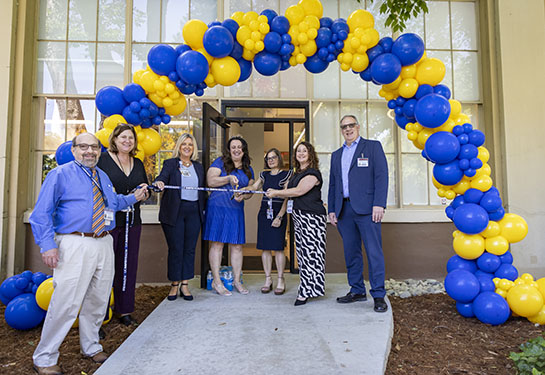Tablet-based screening doubles detection of psychosis symptoms in youth
Asking patients to take a short survey on a tablet before their appointments may help mental health providers identify young people at risk of psychosis. A UC Davis Health study found that when patients took a 21-question pre-visit survey, more than twice as many were identified at risk of psychosis compared to those who did not complete the survey.
But despite the improvement in detecting individuals at risk, the technology-based screening did not reduce the time between the participants’ first psychotic symptoms and when they received treatment.
The findings are in a new UC Davis Health study published in JAMA Psychiatry.
Previous studies have shown that the longer the time between the first psychotic incident — such as hallucinations or delusions — and receiving treatment, the more severe the course of the disease. According to the National Institute of Mental Health, psychosis often begins when a person is in his or her late teens to mid-twenties. About 100,000 new cases of psychosis are diagnosed each year in the U.S.
“The addition of a brief screener at the initial evaluation can make a dramatic difference in clinical decision-making, helping you to realize that an individual needs specialized care,” said Tara A. Niendam, first author of the study. Niendam is a professor and executive director of the UC Davis Health Early Psychosis Programs.

Methods
Data came from ten community clinics and four school sites in California. Sites were divided by those that used tablets for screening (“active screening”) and those that screened using clinical judgment (“treatment as usual”).
For the sites with active screening, individuals between the ages of 12 and 30 completed a questionnaire on a tablet before their visit with a mental health care provider.
Known as the PQ-B (Prodromal Questionnaire, Brief Version), questions included “Do familiar surroundings sometimes seem strange, confusing, threatening or unreal to you?” and “Have you seen things that other people can't see or don't seem to see?”
If the questionnaire score was 20 or above, the participant was offered a referral to an early psychosis clinic for further evaluation.
Sites not using active screening relied on clinical judgment for further evaluation and referrals to early psychosis clinics.
Results
The researchers evaluated data from 2,432 individuals at the active-screening sites and 2,455 at the treatment-as-usual sites.
Active-screening sites reported a significantly higher detection rate of psychosis spectrum disorders, with 136 cases (5.6%), compared to 65 (2.6%) in the sites that did not use the tablet screening.
The active-screening sites also referred 13 individuals with first-episode psychosis compared to four in the sites that did not use active screening.
But despite the early detection, the data showed no statistically significant difference in the duration of untreated psychosis. The mean for the active screening group was 239 days. The mean was 262.3 for the treatment-as-usual group.
The researchers noted this was likely due to multiple factors leading to delayed access to the mental health system in the U.S.
“On average, our participants experienced untreated psychosis for approximately six months before presenting at one of our participating clinic sites,” said Mark Savill, assistant professor in the Department of Psychiatry and Behavioral Sciences and a co-author of the study. “A multifaceted approach that focuses on supporting individuals to seek help quicker and improving the pathway to appropriate services once they present for care may be necessary to achieve meaningful reductions in the duration of untreated psychosis.”
Young people at risk are not being identified
Twenty-four sites agreed to participate. However, only ten community clinics and four school sites were able to fully implement the screening. Some study sites, such as primary care clinics, faced challenges implementing the screenings and reporting feedback; schools struggled with staffing issues and parent engagement.
The setbacks highlight some of the challenges that might be faced scaling up programs that offer the active screening. But the results highlight how many young people at risk of psychosis are not being identified with the current system.
“Population-based screening for psychosis has not been addressed systematically in the U.S. prior to this study,” said Cameron S. Carter, senior author of the paper. Carter is a distinguished professor of psychiatry and psychology and director of the UC Davis Health Imaging Research Center and the Behavioral Health Center for Excellence.
“Our increased identification of cases using the PQ-B questionnaire is an important finding. More people in this active group are getting into care,” Carter said. “That's important because we know from previous research that individuals who are identified and receive treatment at the very early stages in their illness are likely to have the best outcomes.”
If you or a loved one think you may be experiencing symptoms of psychosis, the Early Psychosis Programs at UC Davis Health offer a free online screening survey.
Additional authors on the study include Tyler A. Lesh, Daniel Ragland, Khalima Bolden, Haley Skymba, Sarah Gobrial, Monet Meyer, Katherine Pierce, Adi Rosenthal, Taylor Fedechko, Laura Tully, Valerie Tryon, Rosemary Cress and Richard Kravitz from UC Davis; Rachel Loewy and Kevin Delucchi from UCSF; and Howard Goldman from University of Maryland, Baltimore.
Funding for this study was provided by grants from the National Institute of Mental Health (5R01MH104235) and (5T32MH018261-35).
Resources




